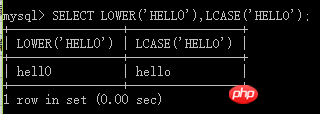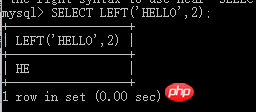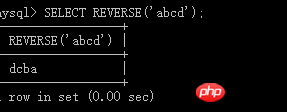Detailed explanation of string functions in MySQL
I saw a question about mysql in the forum today. The question is as follows
good_id cat_id
12654 665,569
12655 601,4722
goods_id is the product id
cat_id is the classification id
How do I check the data based on this classification ID (a product has multiple categories, separated by commas)
I am using like now. In this case, entering a classification id is This product can be found by entering 688 or 4722, but the product can also be found by inputting 722.
If you use like, there will definitely be problems. My initial idea is to replace the string in cat_id with an array, so that the in operation in mysql can be used. In this way, search 722 will not appear, and all products under the 4722 category will appear. I searched for a long time on the Internet, but I couldn't find any string operation function in this area. However, I found that although the find_in_set function cannot convert a string into an array, the above situation will not occur. I found that there were many functions that I didn't know, so I collected them from the manual and the Internet for a long time and made some examples.
CHAR_LENGTH(str) Returns the number of characters in str












 ##REPEAT(s,n) returns a string composed of n s, n<=0, returns empty; s or n is NULL, returns NULL
##REPEAT(s,n) returns a string composed of n s, n<=0, returns empty; s or n is NULL, returns NULL
 SPACE(n) Returns n space strings
SPACE(n) Returns n space strings
 REPLACE(s,s1,s2) Returns --replacing s with s2 The result of all s1 strings
REPLACE(s,s1,s2) Returns --replacing s with s2 The result of all s1 strings
##STRCPM(s1,s2) s1==s2 returns 0 s1 SUBSTRING(s,n,len), MID(s,n,len) returns a string of len length starting from n. If n<0, it starts from the last reciprocal of s. Start intercepting n characters. If n=0, an empty string will be returned; len can be omitted - all characters after n will be intercepted LOCATE(str1, str2), POSITION(str1 IN str2), INSTR(str2, str1) Return the starting position of str1 in str2 REVERSE(s) Returns the reverse of the string of s ELT(n,str1,str2, str3...) Returns the nth string in str1, str2.., if n exceeds return null FIELD(s,str1,str2,str3.. ..) Returns the position of the first occurrence of s in str1, str2..., without returning 0 FIND_IN_SET(s,str1) Returns the position of s in The position of occurrence in str1, where str1 consists of multiple strings, a comma-separated list The above is the detailed content of Detailed explanation of string functions in MySQL. For more information, please follow other related articles on the PHP Chinese website!









Hot AI Tools

Undresser.AI Undress
AI-powered app for creating realistic nude photos

AI Clothes Remover
Online AI tool for removing clothes from photos.

Undress AI Tool
Undress images for free

Clothoff.io
AI clothes remover

Video Face Swap
Swap faces in any video effortlessly with our completely free AI face swap tool!

Hot Article

Hot Tools

Notepad++7.3.1
Easy-to-use and free code editor

SublimeText3 Chinese version
Chinese version, very easy to use

Zend Studio 13.0.1
Powerful PHP integrated development environment

Dreamweaver CS6
Visual web development tools

SublimeText3 Mac version
God-level code editing software (SublimeText3)

Hot Topics
 1386
1386
 52
52
 MySQL: Simple Concepts for Easy Learning
Apr 10, 2025 am 09:29 AM
MySQL: Simple Concepts for Easy Learning
Apr 10, 2025 am 09:29 AM
MySQL is an open source relational database management system. 1) Create database and tables: Use the CREATEDATABASE and CREATETABLE commands. 2) Basic operations: INSERT, UPDATE, DELETE and SELECT. 3) Advanced operations: JOIN, subquery and transaction processing. 4) Debugging skills: Check syntax, data type and permissions. 5) Optimization suggestions: Use indexes, avoid SELECT* and use transactions.
 How to open phpmyadmin
Apr 10, 2025 pm 10:51 PM
How to open phpmyadmin
Apr 10, 2025 pm 10:51 PM
You can open phpMyAdmin through the following steps: 1. Log in to the website control panel; 2. Find and click the phpMyAdmin icon; 3. Enter MySQL credentials; 4. Click "Login".
 MySQL: An Introduction to the World's Most Popular Database
Apr 12, 2025 am 12:18 AM
MySQL: An Introduction to the World's Most Popular Database
Apr 12, 2025 am 12:18 AM
MySQL is an open source relational database management system, mainly used to store and retrieve data quickly and reliably. Its working principle includes client requests, query resolution, execution of queries and return results. Examples of usage include creating tables, inserting and querying data, and advanced features such as JOIN operations. Common errors involve SQL syntax, data types, and permissions, and optimization suggestions include the use of indexes, optimized queries, and partitioning of tables.
 How to use single threaded redis
Apr 10, 2025 pm 07:12 PM
How to use single threaded redis
Apr 10, 2025 pm 07:12 PM
Redis uses a single threaded architecture to provide high performance, simplicity, and consistency. It utilizes I/O multiplexing, event loops, non-blocking I/O, and shared memory to improve concurrency, but with limitations of concurrency limitations, single point of failure, and unsuitable for write-intensive workloads.
 Why Use MySQL? Benefits and Advantages
Apr 12, 2025 am 12:17 AM
Why Use MySQL? Benefits and Advantages
Apr 12, 2025 am 12:17 AM
MySQL is chosen for its performance, reliability, ease of use, and community support. 1.MySQL provides efficient data storage and retrieval functions, supporting multiple data types and advanced query operations. 2. Adopt client-server architecture and multiple storage engines to support transaction and query optimization. 3. Easy to use, supports a variety of operating systems and programming languages. 4. Have strong community support and provide rich resources and solutions.
 MySQL's Place: Databases and Programming
Apr 13, 2025 am 12:18 AM
MySQL's Place: Databases and Programming
Apr 13, 2025 am 12:18 AM
MySQL's position in databases and programming is very important. It is an open source relational database management system that is widely used in various application scenarios. 1) MySQL provides efficient data storage, organization and retrieval functions, supporting Web, mobile and enterprise-level systems. 2) It uses a client-server architecture, supports multiple storage engines and index optimization. 3) Basic usages include creating tables and inserting data, and advanced usages involve multi-table JOINs and complex queries. 4) Frequently asked questions such as SQL syntax errors and performance issues can be debugged through the EXPLAIN command and slow query log. 5) Performance optimization methods include rational use of indexes, optimized query and use of caches. Best practices include using transactions and PreparedStatemen
 MySQL and SQL: Essential Skills for Developers
Apr 10, 2025 am 09:30 AM
MySQL and SQL: Essential Skills for Developers
Apr 10, 2025 am 09:30 AM
MySQL and SQL are essential skills for developers. 1.MySQL is an open source relational database management system, and SQL is the standard language used to manage and operate databases. 2.MySQL supports multiple storage engines through efficient data storage and retrieval functions, and SQL completes complex data operations through simple statements. 3. Examples of usage include basic queries and advanced queries, such as filtering and sorting by condition. 4. Common errors include syntax errors and performance issues, which can be optimized by checking SQL statements and using EXPLAIN commands. 5. Performance optimization techniques include using indexes, avoiding full table scanning, optimizing JOIN operations and improving code readability.
 Monitor Redis Droplet with Redis Exporter Service
Apr 10, 2025 pm 01:36 PM
Monitor Redis Droplet with Redis Exporter Service
Apr 10, 2025 pm 01:36 PM
Effective monitoring of Redis databases is critical to maintaining optimal performance, identifying potential bottlenecks, and ensuring overall system reliability. Redis Exporter Service is a powerful utility designed to monitor Redis databases using Prometheus. This tutorial will guide you through the complete setup and configuration of Redis Exporter Service, ensuring you seamlessly build monitoring solutions. By studying this tutorial, you will achieve fully operational monitoring settings




